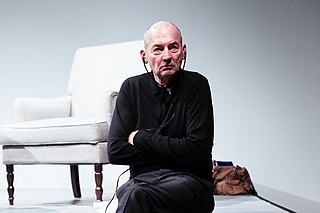
Remment Lucas Koolhaas is a Dutch architect, architectural theorist, urbanist and Professor in Practice of Architecture and Urban Design at the Graduate School of Design at Harvard University. He is often cited as a representative of Deconstructivism and is the author of Delirious New York: A Retroactive Manifesto for Manhattan.

Rotterdam is the second-largest city in the Netherlands after the national capital of Amsterdam. It is in the province of South Holland, part of the North Sea mouth of the Rhine–Meuse–Scheldt delta, via the "New Meuse" inland shipping channel, dug to connect to the Meuse at first and now to the Rhine.

MVRDV is a Rotterdam, Netherlands-based architecture and urban design practice founded in 1993, with additional offices in Berlin, New York, Paris, and Shanghai. It is currently regarded as one of the world's finest architecture firms. MVRDV is an acronym of the founding members' surnames: Winy Maas, Jacob van Rijs, and Nathalie de Vries.
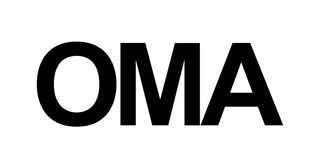
The Office for Metropolitan Architecture (OMA) is an international architectural firm with offices in Rotterdam, New York, Hong Kong, Doha, and Australia. The firm is currently led by eight partners - Rem Koolhaas, Reinier de Graaf, Ellen van Loon, Shohei Shigematsu, Iyad Alsaka, Chris van Duijn, Jason Long, and managing partner and architect David Gianotten.

Contemporary architecture is the architecture of the 21st century. No single style is dominant. Contemporary architects work in several different styles, from postmodernism, high-tech architecture and new interpretations of traditional architecture to highly conceptual forms and designs, resembling sculpture on an enormous scale. Some of these styles and approaches make use of very advanced technology and modern building materials, such as tube structures which allow construction of buildings that are taller, lighter and stronger than those in the 20th century, while others prioritize the use of natural and ecological materials like stone, wood and lime. One technology that is common to all forms of contemporary architecture is the use of new techniques of computer-aided design, which allow buildings to be designed and modeled on computers in three dimensions, and constructed with more precision and speed.
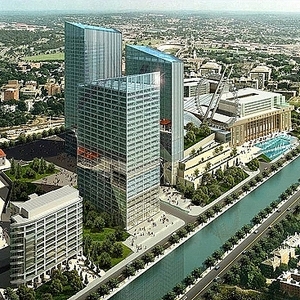
The Dâmbovița Center is an unfinished building in Bucharest, Romania, near Cotroceni, on the shore of the Dâmbovița River. Casa Radio was erected during the late 1980s by the Communist regime on land which before the Second World War was the location of the Bucharest Hippodrome. The building was intended to serve as a museum of the Romanian Communist Party. The balcony of the unfinished building facing Știrbei Vodă Street was used by the Romanian dictator Nicolae Ceaușescu on 23 August 1989 to watch the festivities marking Romania's National Day. It was the last Communist-style parade in Romania.

The CCTV Headquarters is a 51-floor skyscraper formed out of a pair of conjoined towers that sits on the East Third Ring Road, Guanghua Road in the Beijing Central Business District (CBD) and serves as the headquarters for China Central Television (CCTV). Rem Koolhaas and Ole Scheeren of OMA were the architects in charge for the building, while Cecil Balmond at Arup provided the complex engineering design.

The Embassy of the Netherlands in Berlin is the Netherlands's diplomatic mission in Berlin, Germany. Designed by Rem Koolhaas of OMA, the building was opened in 2004.

1600 Pacific Tower, also known as the LTV Tower, is a skyscraper in the City Center District of Dallas, Texas, USA. The building rises 434 feet. The structure contains 33 floors, made up originally of office space, standing as the 29th-tallest building in the city. The building is adjacent to Thanks-Giving Square and was, for a time, connected to the Dallas Pedestrian Network.

The Netherlands Architecture Institute (NAI) was a cultural institute for architecture and urban development, which comprised a museum, an archive plus library and a platform for lectures and debates. The NAI was established in 1988 and was based in Rotterdam since 1993. It ceased to exist in 2013, when it became part of Het Nieuwe Instituut.

De Zalmhaven, also referred to as Zalmhaventoren, is a project that includes a 215 metres (705 ft) residential tower in Rotterdam, the Netherlands. Other parts of the project are two buildings of 70m each. The project was approved by the city in February 2010.

The Maastoren is with its height of 165 metres the second tallest building in the Netherlands. The office building is situated on the bank of the Nieuwe Maas, after which the building is named, in the neighborhood Kop van Zuid in the South Holland city of Rotterdam. The Maastoren was built between 2006 and 2009, and had OVG as its developer. The Maastoren has a total of 44 above ground floors and two underground floors.
Petra Blaisse is a British-born Dutch designer. Her work is an intersection of the professions of architecture, interior architecture, landscape architecture, textile design, and exhibition design.
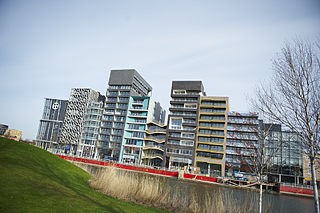
Zilverparkkade is a street in Lelystad, Netherlands, containing a continuous row of wall-to-wall buildings constructed between 2002 and 2007. The name is used to refer to the group of buildings as a whole, as they were constructed together as an architectural project within the framework of renovation of the city center of Lelystad. The word kade means "quay" or "embankment", as the buildings face an artificial body of water within a small park called Zilverpark.

The Maupoleum (1971–1994) was a building on Amsterdam's Jodenbreestraat. Built in 1971, it acquired a reputation for being unattractive before being demolished in 1994.
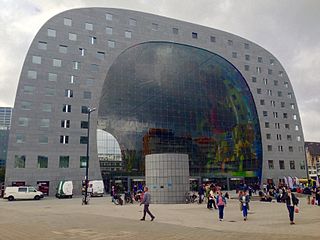
The Markthal is a residential and office building with a market hall underneath, located in Rotterdam. The building was opened on October 1, 2014, by Queen Máxima of the Netherlands. Besides the large market hall, the complex houses 228 apartments, 4,600 m2 retail space, 1,600 m2 horeca and an underground 4-storey parking garage with a capacity of over 1200 cars.
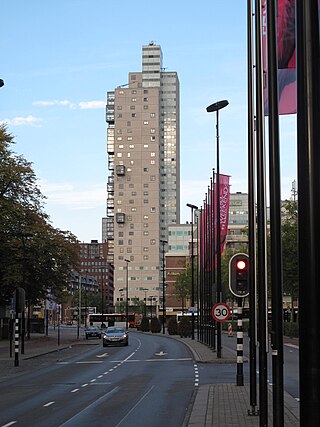
The StadsHeer is a building in the neighborhood Haestrechtkwartier in the Dutch city of Tilburg. The building is 101 metres tall and has 31 above ground floors. Therefore, it is the second tallest building in Tilburg after Westpoint Tower. The lower six floors are occupied by offices and the upper 25 floors by 85 rental apartment units.

The Schielandtoren is a 101 metres tall apartment building in the Dutch city Rotterdam. The building is situated along Bulgersteyn, a street, and is part of a city block with shops among other things. The city block is part of the multipurpose complex Beursplein. Het Schielandshuis, a 17th-century building, is located across the street. The building has a total of 32 aboveground floors with 109 apartments. The floor area amounts to 18,300 m2 (197,000 sq ft). A parking garage of Q-Park with 435 parking spaces is located in close proximity of the Schielandtoren.

Delirious New York: A Retroactive Manifesto for Manhattan is a 1978 book, written by Dutch architect Rem Koolhaas. The book serves as a retroactive manifesto for Manhattan between 1850 and 1960, analyzing the development of architecture and urban design throughout New York's history from the founding of New Amsterdam by the Dutch, to the design of the Headquarters of the United Nations by Le Corbusier. Rem Koolhaas describes the concept of 'Manhattanism', the theory of the creation and functioning of the city of New York, at length in the book.

Four, also known as Four Frankfurt, is a major, luxury mixed-use skyscraper project in Frankfurt, consisting of a complex of four skyscrapers under construction. It is located in the area known as the Deutsche Bank triangle in the Innenstadt borough. The tallest skyscraper will have a height of 233 metres (764 ft), making it Europe's largest residential tower by occupied floor space. Germany's largest building, the Commerzbank Tower is larger by building height but not when measured by occupied floor space height. By total building height it is both Frankfurt and Germany's third-tallest building upon its estimated completion in 2023. Dutch star-architect and student of Zaha Hadid, Ben van Berkel has designed and developed the building.






















